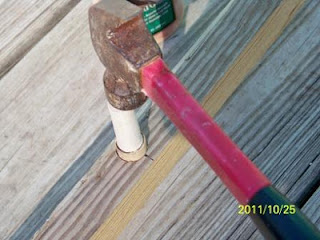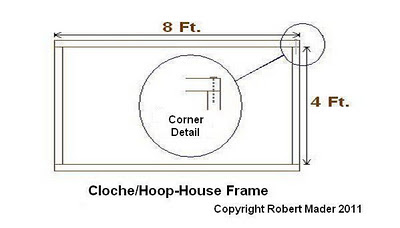How to Make a Miniature Kitchen Table Greenhouse
Here it is, the depth of winter and I'm caught with Stevia plants that I need to keep alive till Spring when I can set them out safely. At the end of last fall, after harvesting the only Stevia plant I had - which is an annual in the Midwest U.S.; all I could do was save some of the more viable stems and try to root them. My success rate was about 40%. So. Now what? How can I keep them alive till Spring without spending a lot of money on a heated greenhouse? I decide to build a miniature greenhouse that could be set in any room and keep my plants alive till Spring.
I needed something small, easy, and fast to protect my new Stevia starts until I could come up with something better. I took my little potted starts and put them in an ordinary rectangle cake pan. Shoved them into a semi-clear plastic grocery bag, And put them under a goose neck desk lamp with one of those fancy new corkscrew fluorescent lights. They give off good plant light but little or no heat. The light was the Equivalent of a 100 watt light source but uses about 27 watts of electricity. This kept my plants pretty snug until I could come up with something better. I then planned out and built this tiny greenhouse. The size of a Cake Pan. The plants go in the pan, and the little greenhouse just sets over it. That's it. Keep the lights on about 12 to 16 hours a day and water when necessary.
Your new babies should thrive. Oh. Keep in a warm room. Normal temperature for humans is great. Take the plants out on occasion and mist them if the seem to be too dry. They can be damp in the soil and still be hurt by dry air in a home especially with gas heating.
I needed something small, easy, and fast to protect my new Stevia starts until I could come up with something better. I took my little potted starts and put them in an ordinary rectangle cake pan. Shoved them into a semi-clear plastic grocery bag, And put them under a goose neck desk lamp with one of those fancy new corkscrew fluorescent lights. They give off good plant light but little or no heat. The light was the Equivalent of a 100 watt light source but uses about 27 watts of electricity. This kept my plants pretty snug until I could come up with something better. I then planned out and built this tiny greenhouse. The size of a Cake Pan. The plants go in the pan, and the little greenhouse just sets over it. That's it. Keep the lights on about 12 to 16 hours a day and water when necessary.
Your new babies should thrive. Oh. Keep in a warm room. Normal temperature for humans is great. Take the plants out on occasion and mist them if the seem to be too dry. They can be damp in the soil and still be hurt by dry air in a home especially with gas heating.
MATERIAL:
- A Sheet of fairly Clear Plastic - About 3 Ft x 4 Ft. This can be gotten from a $1 Painting sheet at the Dollar Store or Storm window material at the hardware store, or (more expensive ) rolls of plastic at 2, 4, 6 mil thickness in rolls at the Big Box store or local hardware store.
- About 20 Sturdy Thumbtacks or Carpet Tacks
- 5 ft of 1x2 or 1 x3 fairly Clear Lumber.(I used cabinet grade plywood strips because that is what I had handy.)
- Standard Size Rectangle Cake Pan.
- 10 ft. of Heavy Wire - #9 or approx. 1/8 inch thickness. Aluminum is easy to bend but more expensive than regular wire for farm use etc. Sometimes called clothesline wire but must be stiff, not braided plastic covered type.
- 1" Wire Brads (small headless nails )
- Waterproof Wood Glue ( I use Titebond III (R).
TOOLS
- Hand Saw to cut the wood strips to length
- Hand Power Drill to drill holes to hold wire hoops in wood strips and Drill Bit slightly larger than wire thickness. Wire should fit snug in the hole. Not tight or loose.
- Tape Measure
- Scissors to trim plastic to size
- Small Hammer
- Wire Cutter (or Hack Saw) to make a nice clean square cut.
- Drawing Compass A $1 cheap Dollar Store School Compass will work fine. A pencil is usually provided.
First cut the wood strips. Measure the length and width of the cake pan at the widest parts (Top edges) and add about 1/4 inch to the length and width of the pieces so the pan will easily slide in and out of the wood frame.
I used thinner wood strips on the ends because I didn't need the thickness to support wire hoops. It helped make the whole thing a little lighter. First glue the ends. Then hammer in about 3 brads. Also try to keep the frame squared up as possible. Make 2 diagonal measurements from one end to the other and then from the opposite corners (diagonally again.) The two measurements should be within a 16th of an inch or so and the frame will be square. If not, check for accurate measurements on the strip lengths.
Next, Drill two wire hoop holes on each end straight across from each other. Then two evenly spaced holes on each side evenly spaced and across from each other. Try to keep the holes straight up and down in the wood and centered.
How to Make the Hoops
Once the wood frame is finished. It is time to make a Template to measure off your wire and to shape it to make 4 nice hoops. Measure across from one hole in the frame to the opposite hole. This is the measurement that will give you the diameter of a circle.
Draw out the Circle on a board or heavy cardboard or your wife's kitchen table...lightly so you can erase it before she catches you!
 Cut the circle in half. This is the curve of your hoop. Draw down from the ends of the half circle a straight line on each side. The straight lengths should be around 7 inches or so long. Measure the total length around the template. Start from one straight end and continue up around the curve and down the other side. This gives you the length of wire to cut.
Cut the circle in half. This is the curve of your hoop. Draw down from the ends of the half circle a straight line on each side. The straight lengths should be around 7 inches or so long. Measure the total length around the template. Start from one straight end and continue up around the curve and down the other side. This gives you the length of wire to cut. Cut 4 wire lengths to this measurement. They should be somewhere around 29 or 30 inches.
Insert the wire hoops into the wood frame. They should fit snug but not tight so you can push them into the holes without bending the wire. I have used a piece of tape to indicate on the wire when it is completely in the hole. All wires should inset to the same length. From at least 1" to the full length of the height of the frame. The longer the better but also the harder to get in.
When all the wires are installed in the wood frame. Lay the plastic cover over the hoops and even out on the ends and the sides. Snug up the plastic cover, Thumbtack to the bottom of the frame. Trim off the extra. You may now set the little greenhouse frame over the cake pan full of little plants. Set a light over them and you are fixed to go! I find that a desk lamp at each end gives plenty of light for starting new seedlings, cuttings, etc.
Copyright 2012 Robert Mader
All Rights Reserved
For any additional questions, just e-mail me at
RobertLee97@Gmail.Com






























































